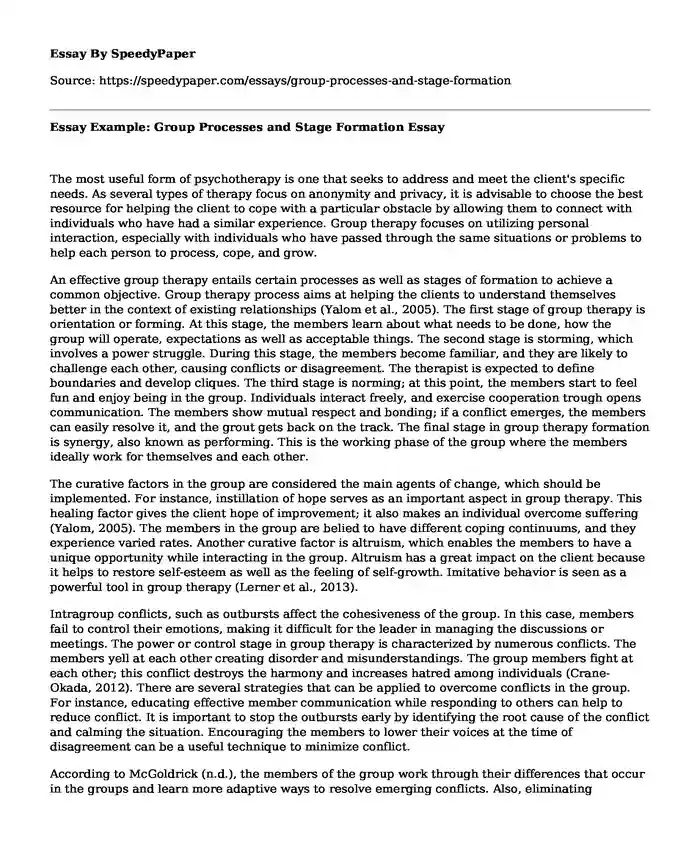
| Type of paper: | Essay |
| Categories: | Consciousness Mental health Interpersonal communication |
| Pages: | 3 |
| Wordcount: | 742 words |
The most useful form of psychotherapy is one that seeks to address and meet the client's specific needs. As several types of therapy focus on anonymity and privacy, it is advisable to choose the best resource for helping the client to cope with a particular obstacle by allowing them to connect with individuals who have had a similar experience. Group therapy focuses on utilizing personal interaction, especially with individuals who have passed through the same situations or problems to help each person to process, cope, and grow.
An effective group therapy entails certain processes as well as stages of formation to achieve a common objective. Group therapy process aims at helping the clients to understand themselves better in the context of existing relationships (Yalom et al., 2005). The first stage of group therapy is orientation or forming. At this stage, the members learn about what needs to be done, how the group will operate, expectations as well as acceptable things. The second stage is storming, which involves a power struggle. During this stage, the members become familiar, and they are likely to challenge each other, causing conflicts or disagreement. The therapist is expected to define boundaries and develop cliques. The third stage is norming; at this point, the members start to feel fun and enjoy being in the group. Individuals interact freely, and exercise cooperation trough opens communication. The members show mutual respect and bonding; if a conflict emerges, the members can easily resolve it, and the grout gets back on the track. The final stage in group therapy formation is synergy, also known as performing. This is the working phase of the group where the members ideally work for themselves and each other.
The curative factors in the group are considered the main agents of change, which should be implemented. For instance, instillation of hope serves as an important aspect in group therapy. This healing factor gives the client hope of improvement; it also makes an individual overcome suffering (Yalom, 2005). The members in the group are belied to have different coping continuums, and they experience varied rates. Another curative factor is altruism, which enables the members to have a unique opportunity while interacting in the group. Altruism has a great impact on the client because it helps to restore self-esteem as well as the feeling of self-growth. Imitative behavior is seen as a powerful tool in group therapy (Lerner et al., 2013).
Intragroup conflicts, such as outbursts affect the cohesiveness of the group. In this case, members fail to control their emotions, making it difficult for the leader in managing the discussions or meetings. The power or control stage in group therapy is characterized by numerous conflicts. The members yell at each other creating disorder and misunderstandings. The group members fight at each other; this conflict destroys the harmony and increases hatred among individuals (Crane-Okada, 2012). There are several strategies that can be applied to overcome conflicts in the group. For instance, educating effective member communication while responding to others can help to reduce conflict. It is important to stop the outbursts early by identifying the root cause of the conflict and calming the situation. Encouraging the members to lower their voices at the time of disagreement can be a useful technique to minimize conflict.
According to McGoldrick (n.d.), the members of the group work through their differences that occur in the groups and learn more adaptive ways to resolve emerging conflicts. Also, eliminating threatening behavior in the group enable the leader to protect the cohesiveness of the group, thus reducing conflicts. It is believed that the members of group therapy have undisturbed emotions, and they require close monitoring to prevent interpersonal conflicts (Harwood, 2009).
References
Crane-Okada, R. (2012). The concept of presence in group psychotherapy: An operational definition. Perspectives in Psychiatric Care, 48(3), 156-164. doi:10.1111/j.1744-6163.2011.00320.x
Harwood, I. H. (2009). The application of self-psychology concepts to group process and group therapy. International Journal of Group Psychotherapy, 27, 343-359. doi: 10.1080/00207284.1983.11491346
Lerner, M. D., McLeod, B. D., & Mikami, A. Y. (2013). Preliminary evaluation of an observational measure of group cohesion for group psychotherapy. Journal of Clinical Psychology, 69(3), 191-208. doi:10.1002/jclp.21933
McGoldrick, M. (n.d.). The legacy of unresolved loss: A family systems approach [Video file]. Retrieved from http://www.psychotherapy.net.ezp.waldenulibrary.org/stream/waldenu/video?vid=013&clip=cs42710ce587410Yalom, I. D., & Leszcz, M. (2005). The theory and practice of group psychotherapy (5th ed.). New York, NY: Basic Books. doi: 10.1111/j.1749-6632.1948.tb30971.x
Cite this page
Essay Example: Group Processes and Stage Formation. (2023, Jan 25). Retrieved from https://speedypaper.com/essays/group-processes-and-stage-formation
Request Removal
If you are the original author of this essay and no longer wish to have it published on the SpeedyPaper website, please click below to request its removal:
- Essay Sample on the US-China Conflict Resolution
- Cox Simulation and Reflection, Free Essay in Nursing Leadership
- Statistics Essay Example on the Application of the Regression Model
- Medical Law Essay Example: Patient Confidentiality
- Free Essay Describing William Bradford Personality and Leadership Skills
- Essay Sample on Chile Business Culture
- Essay Sample on Preserving the Land
Popular categories




